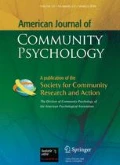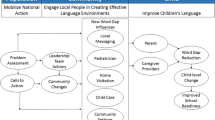Abstract
Participatory Action Research (PAR) with children and youth is at the intersection of child wellness and social inclusion. Exclusion and marginalization detract from personal and collective health. Inclusion, on the contrary, contributes to wellness. Hence, we should study inclusion and exclusion in the overall context of child wellness. This special issue offers a wealth of methodologies and lessons for fostering inclusion of young people through PAR. In an effort to synthesize my concerns with child wellness, inclusion, and the scholarly work of this special issue, this paper will (a) articulate the values underpinning the philosophy of social inclusion and child wellness, (b) suggest roles and responsibilities for putting these values into action, and (c) integrate the contributions of this special issue into the emerging framework for social inclusion and child wellness.

Similar content being viewed by others
References
Adams, M. (2005). American backlash: The untold story of social change in the United States. Toronto: Penguin.
Alsop, R., Bertelsen, M., & Holland, J. (2006). Empowerment in practice: From analysis to implementation. Washington, DC: The World Bank.
Andresen, J., & Siim, B. (Eds.). (2004). Politics of inclusion and empowerment: Gender, class and citizenship. New York: Palgrave Macmillan.
Baker, W. (2008). America the traditional. In T. Pettersson & Y. Esmer (Eds.), Changing values, persisting cultures: Case studies in value change (pp. 9–44). Boston: Brill.
Belfield, C., & Levin, H. (Eds.). (2007). The price we pay: Economic and social consequences of inadequate education. Washington, DC: The Brookings Institution.
Bell, D. (1993). Communitarianism and its critics. Oxford: Clarendon.
Chen, P., Weiss, F. L., & Nicolson, H. J. (2010). Girls study girls Inc.: Engaging girls in evaluation through participatory action research. American Journal of Community Psychology. doi:10.1007/s10464-010-9328-7.
Clark, A. (2010). Young children as protagonists and the role of participatory, visual methods in engaging multiple perspectives. American Journal of Community Psychology.
Damon, W. (1995). Greater expectations: Overcoming the culture of indulgence in America’s homes and schools. New York: The Free Press.
Duckett, P., Kagan, C., & Sixsmith, J. (2010). Consultation and participation with children in healthy schools: Choice, conflict and context. American Journal of Community Psychology.
Etzioni, A. (1993). The spirit of community. New York: Touchstone.
Febbraro, A. (1994). Single mothers “at risk” for child maltreatment: An appraisal of person-centred interventions and a call for emancipatory action. Canadian Journal of Community Mental Health, 13(2), 47–60.
Foster-Fishman, P. G., Law, K. M., Lichty, L. F., & Aoun, C. (2010). Youth ReACT for social change: A method for youth participatory action research. American Journal of Community Psychology. doi:10.1007/s10464-010-9316-y.
Future of Children (2009). Preventing child maltreatment. The Future of Children, 19(2), (Special Issue).
Gergen, K. (2009). Relational being: Beyond self and community. New York: Oxford University Press.
Gil, D. G. (1996). Preventing violence in a violent society: Mission impossible. American Journal of Orthopsychiatry, 66, 77–84.
Imig, D. (2006). Building a social movement for America’s children. Journal of Children in Poverty, 12(1), 21–37.
Institute of Medicine. (1994). Reducing risks for mental disorders: Frontiers for preventive intervention research. Washington, DC: National Academy Press.
Kellett, M. (2010). Small shoes, big steps! Empowering children as active researchers. American Journal of Community Psychology. doi:10.1007/s10464-010-9324-y.
Kitchen, B. (1995). Children and the case for distributive justice between generations in Canada. Child Welfare, LXXIV, 430–458.
Klasen, S. (1998). Social exclusion and children in OECD countries: Some conceptual issues. OECD: Centre for Educational Research and Innovation. Available from http://www.oecd.org/els/edu/ceri/conf220299.htm.
Liegghio, M., Nelson, G., & Evans, S. D. (2010). Partnering with children diagnosed with mental health issues: Contributions of a sociology of childhood perspective to participatory action research. American Journal of Community Psychology.
Lord, J., & Hutchison, P. (2007). Pathways to inclusion: Building a new story with people and communities. Concord, Ontario: Captus.
Maglajlic Holicek, R. A. (2010). “Big organisations” supporting “small involvement”—lessons from Bosnia and Herzegovina on enabling community-based participation of children through PAR. American Journal of Community Psychology.
Minow, M., & Weissbourd, R. (1993). Social movements for children. Daedalus, 122.
Nelson, G., Amio, J., Prilleltensky, I., & Nickels, P. (2000). Partnerships for implementing school and community prevention programs. Journal of Educational and Psychological Consultation, 11, 121–145.
Nelson, G., & Prilleltensky, I. (Eds.). (2010). Community psychology: In pursuit of liberation and well-being (2nd ed.). Palgrave/Macmillan.
Nelson, G., Prilleltensky, I., Laurendeau, M. C., & Powell, B. (1996). A survey of prevention activities in mental health in the Canadian provinces and territories. Canadian Psychology, 37(3), 161–172.
Nelson, G., Prilleltensky, I., & McGillivary., H. (2001). Value-based partnerships: Toward solidarity with oppressed groups. American Journal of Community Psychology, 29, 778–794.
Newman Phillips, E., Berg, M. J., Rodriguez, C., & Morgan, D. (2010). A case study of participatory action research in a public New England middle school: Empowerment, constraints and challenges. American Journal of Community Psychology.
NIMH Committee on Prevention Research. (1995). A plan for prevention research for the National Institute of Mental Health (A report to the National Advisory Mental Health Council). Washington, DC: NIMH Committee on Prevention Research.
O’Connell, M., Boat, T., & Warner, K. (2009). Preventing mental, emotional, and behavioral disorders among young people: Progress and possibilities. Washington, DC: The National Academies Press.
Orr, M. (Ed.). (2007). Transforming the city: Community organizing and the challenge of political change. Lawrence, KS: University Press of Kansas.
Ozer, E., Gaddis, M. L., & Ritterman, M. G. (2010). Participatory action research (PAR) in middle school: Opportunities, constraints, and key processes. American Journal of Community Psychology.
Porter, G., Hampshire, K., Bourdillon, M., Robson, E., Munthali, A., Abane, A. et al. (2010). Children as research collaborators: Issues and reflections from a mobility study in sub-Saharan Africa. American Journal of Community Psychology. doi:10.1007/s10464-010-9317-x.
Prilleltensky, I. (1994). The morals and politics of psychology: Psychological discourse and the status quo. Albany, NY: State University of New York Press.
Prilleltensky, I. (2008). The role of power in wellness, oppression, and liberation: The promise of psychopolitical validity. Journal of Community Psychology, 36(2), 116–136.
Prilleltensky, I., & Nelson, G. (2000). Promoting child and family wellness: Priorities for psychological and social interventions. Journal of Community and Applied Social Psychology, 10, 85–105.
Prilleltensky, I., & Prilleltensky, O. (2006). Promoting well-being: Linking personal, organizational, and community change. New York: Wiley.
Prilleltensky, I., Prilleltensky, O., & Voorhees, C. (2007). Psychopolitical validity in the helping professions: Applications to research, interventions, case conceptualization, and therapy. In C. Cohen & S. Tamiami (Eds.), Liberatory psychiatry: Towards a new psychiatry (pp. 105–130). New York: Cambridge University Press.
Ren, J. Y., & Langhout, R. D. (2010). A recess evaluation with the players: Taking steps toward participatory action research. American Journal of Community Psychology. doi:10.1007/s10464-010-9320-2.
Rutter, M. (1987). Psychosocial resilience and protective mechanisms. American Journal of Orthopsychiatry, 57, 316–331.
Sandel, M. (1996). Democracy’s discontent. Cambridge, MA: Harvard University Press.
Taylor-Ide, D., & Taylor, C. (2002). Just and lasting change: When communities own their futures. Baltimore, MD: Johns Hopkins.
Van Sluys, K. (2010). Trying on and trying out: Participatory action research as a tool for literacy and identity work in middle grades classrooms. American Journal of Community Psychology. doi:10.1007/s10464-010-9319-8.
Wagner, A., Castella Sarriera, J., & Casas, F. (2009). Os direitos da infância: A perspective das crianças, seus pais e professors [Children’s rights: The perspective of children, their parents and teachers]. Porto Alegre, RS, Brazil: Nova Prova.
Watts, R., Williams, N. C., & Jagers, R. (2003). Sociopolitical development. American Journal of Community Psychology, 31, 185–194.
Wilkinson, R., & Pickett, K. (2009). The spirit level: Why more equal societies almost always do better. London: Allen Lane.
Wong, N. T., Zimmerman, M. A., & Parker, E. A. (2010). A typology of youth participation and empowerment for child and adolescent health promotion. American Journal of Community Psychology.
Author information
Authors and Affiliations
Corresponding author
Rights and permissions
About this article
Cite this article
Prilleltensky, I. Child Wellness and Social Inclusion: Values for Action. Am J Community Psychol 46, 238–249 (2010). https://doi.org/10.1007/s10464-010-9318-9
Published:
Issue Date:
DOI: https://doi.org/10.1007/s10464-010-9318-9




